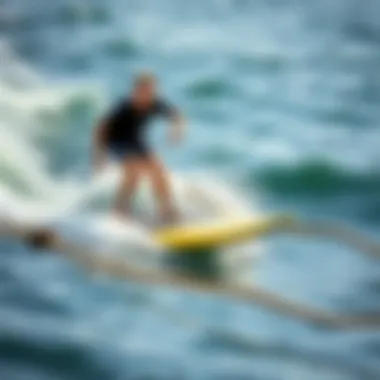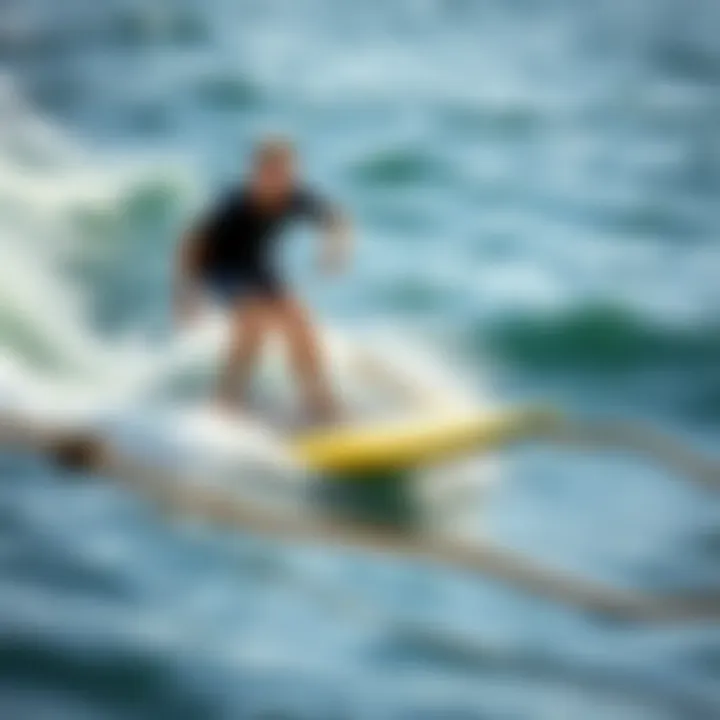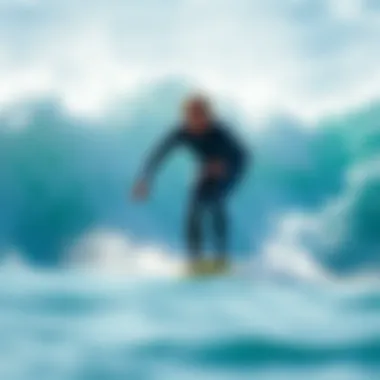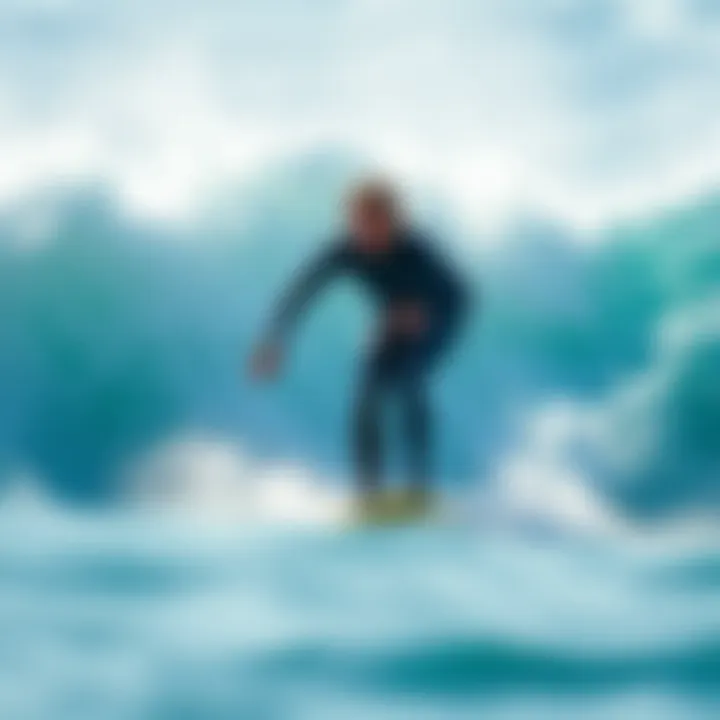Exploring Hydro Foil Surf Boards: A Detailed Analysis


Intro
Hydro foil surf boards have taken the water sports community by storm, merging innovation with the thrill that comes from gliding over water in a whole new way. What sets these boards apart? They lift off the surface and ride above the waves, creating an almost magical feeling for those who dare to try them. Whether you're a seasoned kiteboarder looking to elevate your experience or a curious enthusiast eager to learn about this emerging trend, understanding hydro foil surf boards can enhance your time on the water.
The Appeal of Hydro Foiling
The fascination with hydro foiling lies not just in the thrill of being lifted above the waves, but also in the newfound possibilities it opens up for technique and style. The unique design, which includes a hydrofoil attached beneath the board, allows riders to glide efficiently and with minimal drag. As the foil catches the water, it creates lift, enabling surprising speeds and elegant maneuvers, even in smaller surf or flat water. Considering these benefits, it’s no wonder why more riders are ditching their traditional boards for this innovative gear.
It's also worth noting that hydro foiling is not merely a fad. It’s becoming a significant part of the water sports culture, with an increasing number of enthusiasts investing in this specialized equipment. From instructors to gear manufacturers, everyone sees the practical value of hydro foils, and designs are constantly evolving to cater to varying skill levels.
Exploring Design and Functionality
The importance of design in hydro foil surf boards cannot be overstated. The shape, materials, and size all play critical roles in performance. Materials such as carbon fiber and advanced composites optimize weight and strength, while the shape of the foils and wings determines maneuverability and stability. As riders dive deeper into hydro foiling, they discover more about how these elements interact, leading to a more satisfying riding experience.
> Hydro foiling offers a blend of grace and speed previously unseen in traditional surfing; it’s the perfect medium for those who love the feel of water beneath and air around them.
As we delve deeper into the mechanics, we’ll uncover the maintenance requirements that ensure longevity and optimal performance of these boards, making hydro foiling a sustainable choice for enthusiasts. We will also compare the advantages and challenges faced with traditional surfboards, showcasing how hydro foils stand out in various conditions. So let’s jump in and explore the equipment insights that will inform our understanding of hydro foiling.
Preamble to Hydro Foil Surf Boards
Hydro foil surf boards represent a fascinating intersection of innovation and water sports. As these boards glide above the water's surface, they offer riders a unique experience characterized by smooth rides and an exhilarating sense of speed. Understanding hydro foils, particularly how they work and their advantages over traditional surfboards, is pivotal for anyone keen to explore the cutting edge of water sports.
Definition and Concept
In simple terms, a hydro foil surf board consists of a standard surfboard affixed with a hydrofoil underneath. This hydrofoil looks like a wing, and its job is to lift the board out of the water when it achieves a certain speed. The essence of hydrodynamics comes into play here, as the foil creates lift and minimizes drag, allowing the rider to skim across the surface with reduced resistance. The idea may seem basic, but the precision and engineering behind these boards are quite remarkable.
Here’s how it breaks down:
- Foil Shape: The design of the foil is crucial. Different shapes cater to varying performance needs, such as speed or stability.
- Board Weight: A lighter board can leverage the foil's lift more effectively, enhancing performance.
- Rider Technique: Mastering balance is key; finding the sweet spot often requires practice and skill.
Historical Background
The journey of hydro foiling goes back several decades, with its origins rooted in the 1960s when pioneers like Bob Simmons experimented with various surfboard designs. However, it took until the late 1990s and early 2000s for the technology to mature. One significant milestone was the 2001 introduction of the first commercially viable hydrofoil surfboards. These inventions opened a new world of possibilities for surfing enthusiasts.
During the same period, advancements in material science allowed manufacturers to create safer and more durable boards. Woven carbon fiber, for instance, provided the necessary strength without unnecessary weight. Consequently, hydro foiling began to attract a diverse crowd—from traditional surfers looking to push boundaries, to kiteboarders who sought an edge in performance.
As interest grew, so too did the technology. Designs evolved swiftly through trial and error, leading to innovations that would make hydro foiling more accessible and appealing. Riders who once ignored hydro foils now found themselves captivated by the new sensation of surfing above water. This shift signifies more than a fad; it represents a significant evolution in the realm of water sports that deserves rigorous exploration.
The Mechanics of Hydro Foiling
Understanding the mechanics behind hydro foiling is crucial for anyone looking to delve into the world of modern surfing. This section highlights how the integration of hydrofoils changes the experience of riding waves, enhancing performance, and opening doors to various water conditions which might not be favorable for traditional surfing. The focus is on how these design elements contribute to the overall effectiveness of hydro foil surfboards, making them a remarkable choice for both novices and experienced surfers alike.
Foil Structure and Functionality
Components of a Hydro Foil
A hydro foil consists of several key components that work harmoniously to facilitate the unique riding experience. The essential parts include the mast, wings, and fuselage. Each plays a decisive role in how the board operates in the water.
The mast connects the surfboard to the wings and is crucial for stability. A longer mast allows for a higher ride above the water but requires more skill to prevent tumble when maneuvering. Wings, specifically the front and rear, are designed to lift the board out of the water as speed increases. Experienced riders often tweak the size and shape of the wings for a customized ride tailored to their style and preferences.
- Key Characteristic: Stability and lift
- Benefit: Enhances the ride experience while providing control and speed
- Unique Feature: Many components are made from high-grade materials like carbon fiber for weight reduction and strength, though they can be on the pricier side.
Hydrodynamics Explained
Hydrodynamics plays a pivotal role in understanding how hydro foils operate. Through the principles of fluid dynamics, the shape of the wings and their interactions with water help generate lift. This enables the board to rise above the surface, effectively gliding over the water.
One of the most compelling aspects of hydrodynamics in hydro foiling is that smaller boards can achieve greater speeds with less energy spent, thanks to reduced physical drag. With the right settings, riders can finely tune how the water flows around their board, optimizing both glide and control.
- Key Characteristic: Efficient water flow
- Benefit: Greater speeds and less resistance due to lift
- Unique Feature: Riders can experience a floatation effect, making it feel as if they are flying above the waves, thus providing a new thrill in water sports.
Riding Experience
Balance and Control
When it comes to balance and control, hydro foiling demands a different skill set compared to traditional surfing. Riders must develop a keen sense of stability as they adjust their body position to account for the higher center of gravity that comes with being lifted off the water.
The shift from sitting in the water to flying above it changes the dynamics of weight distribution. It’s vital to keep a low center of gravity while making quick adjustments to maintain balance. This can prove challenging, but it is one of the aspects that many riders find exhilarating. Achieving success with balance translates directly to the overall performance of the foil ride.


- Key Characteristic: Precise body positioning
- Benefit: Enhanced control over the board’s movement
- Unique Feature: As riders become more adept, they can execute sharper turns and maneuvers with greater ease compared to traditional boards, which often require more effort.
Speed and Glide
The thrill of hydro foiling comes not just from the lift off the water, but also from the speed and glide provided by the proper setup. When riders reach sufficient speed, they can literally soar above the waves. This ability to glide effortlessly reduces the coaster-like dragging feeling that comes with traditional boards.
Masters of hydro foiling can carry their speed through turns and enjoy extended rides over flat water or gentle swells. The experience is often described as being akin to gliding over a slick surface, offering a smooth ride that traditional surfing lacks.
- Key Characteristic: Effortless gliding sensation
- Benefit: Greater speed yields a more thrilling ride
- Unique Feature: The right foil setup enables riders to maintain speed even in less-than-ideal conditions, making it ideal for varying environments.
The mechanics of hydro foiling represents a significant leap forward in surf technology, leading to exciting new possibilities. From customizing components to adjusting to the flow of the water, the hydro foiling experience is unlike any other.
Design Variations in Hydro Foil Surf Boards
The world of hydro foil surf boards is not just about gliding over the water; it's also about how these boards are crafted. Design variations play a crucial role in how effectively a board performs under different conditions. Each design element influences factors such as speed, maneuverability, and responsiveness. Understanding these variations can significantly enhance the rider's experience.
Materials Used
Composite Materials
Composite materials are a blend of various substances to create a final product that boasts increased strength and reduced weight. In the context of hydro foil surf boards, they commonly combine plastic, fiberglass, and carbon fibers. This mix provides an ideal balance between durability and performance. The key characteristic of composite materials is their lightweight nature, which leads to better performance on the water.
One unique feature of composite materials used in hydro foils is their ability to resist warping under stress. This means that riders can push the limits without worrying about damage that would typically plague traditional boards. While composite materials tend to be more expensive than standard options, their resilience and lightness often make them well worth the investment.
Aluminum vs Carbon Fiber
When it comes to choosing between aluminum and carbon fiber for hydro foiling, many factors come into play. Aluminum is a robust and affordable material, known for its sturdy construction. It's particularly valued for its ability to withstand rough handling. However, carbon fiber has emerged as the darling among serious riders. Its notable characteristic is its unmatched strength-to-weight ratio, enabling quicker acceleration and sharper tricks.
A unique aspect of carbon fiber is its responsiveness in the water. This material can provide a ‘catch’ that allows surfers to execute efficient turns and transitions. However, it should be noted that carbon fiber boards can be pricier and may require meticulous handling to avoid damage. Balancing the strengths of aluminum against the lightweight performance of carbon fiber is a key consideration for riders.
Board Shapes and Sizes
Short Boards Versus Long Boards
The debate between short and long boards in hydro foiling is akin to the classic battle of classic vs modern. Short boards are designed for agility, allowing riders to maneuver with ease and perform advanced tricks. Their compact size makes them a go-to choice for those looking to harness high speeds and quick turns.
In contrast, long boards provide stability and a smoother ride, making them suitable for beginners. Their extended length allows for enhanced buoyancy, useful for catching waves easily in various surf conditions. Ultimately, the decision between short and long boards hinges on personal riding style and the conditions one plans to encounter.
Tail Shapes and Their Impact
Tail shapes play a subtle yet vital role in a hydro foil board's performance. Boards with different tail designs exhibit distinct behaviors in the water. For instance, a square tail can increase lift and speed, offering a snappier ride, while a rounded tail typically enhances flow and maneuverability.
Each tail shape brings unique qualities that lead to different riding experiences. Riders must consider how tail shapes align with their personal style, whether they prioritize speed or control. A well-chosen tail shape not only complements riding strategies but can also enhance a rider's overall performance on the water.
Advantages of Hydro Foil Boards
Hydro foil boards have made waves in the surfing community, bringing new dimensions to water sports. Their advantages extend beyond just performance; they reshape the way enthusiasts interact with water, offering experiences that traditional surfboards simply can't match. In this section, we’ll navigate through the specific benefits of these innovative boards, considering factors like performance in varying conditions and environmental sustainability.
Increased Performance in Various Conditions
Hydro foil boards boast exceptional performance capabilities, particularly in conditions that might leave other board types floundering. This advantage is particularly notable in different wind conditions and adaptability to diverse water states.
Wind Conditions
When it comes to wind conditions, hydro foil boards stand out. They can harness wind energy effectively, allowing riders to glide effortlessly even in light breezes. This makes them a favorite among kiteboarders or anyone looking to catch waves under less than ideal wind situations. Riders can expect to gain more speed without needing strong gusts. The key characteristic here is the lift created by the foil, which elevates the board above the water. This lift means that even a gentle breeze can propel the rider with surprising swiftness, reducing drag and enhancing the overall riding experience.
However, a double-edged sword exists. While hydro foil boards can adapt to lighter winds, the learning curve might be steep for newcomers who are used to traditional boards. Stabilizing at high speeds may require exceptional balance and practice.
Water State Adaptability
The adaptability of hydro foil boards in various water states is another crown jewel. Whether facing choppy waves or smooth surfaces, hydro foils cut through water with less resistance. This adaptability makes them incredibly versatile and allows for enjoyable rides regardless of the conditions.
Foil boards glide smoothly across the surface, lifting above rough patches that would typically disrupt a traditional surfboard. The beauty of this adaptability lies in the unique feature of the foil design, which provides stability across different surfaces. However, this versatility might not always compensate for a lack of familiarity with the gear. Beginners might find that mastering the required techniques involves more than just hopping on a board.
Environmental Considerations
Hydro foil boards are not just about enhancing performance; they are also embracing environmental mindfulness in several ways. The features contributing to their eco-friendliness include reduced water resistance and the use of sustainable materials.
Reduced Water Resistance


One of the standout aspects of hydro foil boards is their reduced water resistance. This feature not only enhances speed but also contributes to energy efficiency. When a rider spends less energy overcoming drag, they can enjoy longer rides and conserve their stamina. The reduced water resistance signifies that riders can glide farther with less exertion, making it an appealing choice for those who value energy conservation.
As beneficial as this might be, it doesn't come without its caveats. Riders must be aware that this increase in efficiency may lead to faster speeds, which can be intimidating for those not accustomed to high velocities. A gentle touch rather than an aggressive approach is crucial.
Sustainable Materials
Moreover, as the industry evolves, many manufacturers are turning to sustainable materials for constructing hydro foil boards. Using eco-friendly options not only aligns with broader environmental goals but also enhances the overall appeal of the boards. These materials often result in lightweight boards that don’t compromise on strength or durability, making them a wise investment in both performance and sustainability.
This trend toward sustainability might resonate more with environmentally-conscious consumers, highlighting a cultural shift in the surfing and water sports communities. However, the downside is that boards made from sustainable materials may sometimes come at a premium price, potentially placing them out of reach for budget-conscious explorers.
In summary, the advantages of hydro foil boards extend beyond just performance metrics. The enhanced capabilities in varying conditions and a robust stance on environmental responsibility position them as an excellent choice for surfers and kiteboarders alike. As the technology progresses, these boards are set to reshape the waves and the mindset of the water sports realm.
Challenges of Using Hydro Foil Surf Boards
When diving into hydro foiling, it’s essential to be aware of the inherent challenges that come with this innovative sport. Although these boards provide unique experiences and opportunities, the obstacles can raise a few eyebrows for both seasoned riders and newcomers alike. Understanding these challenges is crucial for a fulfilling ride, as it touches on essential aspects that influence performance and enjoyment.
Learning Curve
Essential Skills and Techniques
The learning curve associated with hydro foiling can feel akin to riding a unicycle for the first time: initially daunting but ultimately rewarding. Riders must master balancing on the board while manipulating speed and direction effectively. Key skills include:
- Balance Adjustment: Unlike traditional surfing, where the rider's center of gravity is mainly close to the board, hydro foiling requires adjustments in stance as the board starts to lift. Understanding how to compensate for the increased height above water is vital.
- Speed Regulation: Maintaining the right speed is crucial for keeping the foil airborne. Too slow, and the foil will crash back into the water; too fast, and control can become elusive.
What makes these skills especially significant is the possibility of unlocking a more exhilarating experience once mastered. However, the unique nature of hydro foiling can lead to frustration for beginners as they grapple with their technique. This transformative process requires time and patience, reinforcing the notion that expertise is earned, not given.
Potential Risks of Excessive Speed
Speed can be a double-edged sword in hydro foiling. While the thrill of blaring through the water is enticing, it's paramount to acknowledge the potential risks that can come with excessive speed. One of the critical aspects is:
- Loss of Control: As speed increases, so does the chance of losing control over the board. This can lead to abrupt falls or crashes, which are not just painful but can also discourage novices.
- Dangerous Environments: High speeds can overlook existing hazards such as rocks, other riders, or equipment in the water. Thus, enthusiasts must navigate carefully, ensuring they remain aware of their surroundings.
Although riding fast can be exhilarating, the risks underscore the necessity of caution and skillful navigation in this sport. Those keen on hydro foiling should be mindful of their limits as well as the conditions of the water they surf.
Maintenance Requirements
Another layer of responsibility in hydro foiling comes in the form of maintenance requirements. Just as one needs to keep their vehicle in top shape to ensure smooth rides, the same applies to hydro foil boards. Attention to maintenance not only prolongs the lifespan of the boards but also contributes to safety and performance.
Routine Checks
Routine checks are essential to ensure that both the board and the hydrofoil remain in good condition. This thorough examination encompasses several key areas:
- Foil Integrity: Regularly inspect the connectors and screws for any signs of wear or loose fittings. A loose foil can spell disaster mid-ride.
- Board Surface: Look for cracks or punctures in the foam and laminate, which can affect buoyancy. Addressing these issues promptly can help to prevent more significant problems down the line.
Conducting these checks makes a word-of-mouth difference when it comes to performance and safety. It's an investment of time that pays off during each ride, resulting in smoother, worry-free sessions.
Repairs and Upkeep
In the event that wear and tear become apparent, understanding repairs and upkeep is critical. Hydro foils can take a beating, especially in more aggressive conditions. Knowledge of potential repairs includes:
- Ding Repairs: Knowing how to patch minor dings quickly can facilitate continued enjoyment, as it prevents water from entering the board and compromising durability.
- Foil Cleanup: Regularly cleaning the foil after each session can diminish salt buildup that may corrode metal parts over time, ensuring that the equipment works optimally.
Mastering repairs and upkeep is not only cost-effective but also enhances the relationship between the rider and their gear. The more time you spend tending to your equipment, the more comfortable and confident you will feel when tackling new waters.
Comparative Analysis: Hydro Foil vs. Traditional Surf Boards
In the world of surfing, few discussions are as crucial as the comparison between hydro foil surfboards and traditional surfboards. This analysis holds significant weight as it touches upon performance, user experience, and the evolving preferences of surfers across various skill levels. Understanding the distinctions can inform buyers and enthusiasts alike, guiding their choices in equipment. The shift towards hydro foiling introduces unique features and challenges, which merits a close examination.
Performance Metrics
Speed and Maneuverability
One of the hallmark distinctions in performance lies in speed and maneuverability. Hydro foil surfboards are engineered to slice through water, lifting above the surface. This creates an unparalleled gliding experience that traditional boards can't offer. When a surfer rides a hydro foil board, they find themselves experiencing a sense of weightlessness, reducing water resistance and allowing for quicker acceleration.
The key characteristic here is the hydro foil itself, which elevates the board. Unlike the traditional surfboard that operates on water resistance, the hydro foil propels the surfer forward with less friction. This makes it a beneficial option for those who crave speed and efficiency. However, the unique feature comes with its own set of challenges. While performing tricks becomes smoother, the learning curve can be steep; novice surfers may struggle with balance and control until they adapt to the board's dynamics, leading to possible frustrations.
Durability and Use Cases
Switching gears to durability and use cases, hydro foil boards are crafted with materials and designs that often enhance resilience. The typical construction involves composite designs, often with carbon fibers, making them both lightweight and robust. This means they resist dings and wear-and-tear effectively, which is a key characteristic for kiteboarders facing harsh conditions.


The unique feature of durability with hydro foils is two-fold: not only do they stand up better to the elements, but they also open up diverse use cases beyond conventional surfing. Surfers are venturing into different water states, like choppy or overpowered conditions. On the other hand, traditional surfboards may require more attention to detail in maintenance, especially regarding storage and handling to maintain longevity. The trade-off here is that while hydro foils may be prone to higher initial costs, the durability can lead to fewer purchases in the long term.
User Preferences
Beginner vs Advanced Users
When diving into beginner versus advanced users, we're looking at a divergence in user preferences. For beginners, traditional surfboards often provide a more intuitive experience, easier to balance on and maneuver. The wider and more stable shape gives novices the confidence they need to catch waves without feeling like they're constantly teetering on the edge of a spill.
On the other hand, as surfers progress, they often seek out the thrills offered by hydro foils. The key characteristic for advanced users includes the ability to perform complex maneuvers at high speeds. Here, hydro foiling becomes beneficial for those looking to push their limits, however, it also poses unique challenges with a steeper learning curve that can be intimidating to newcomers or even intermediate users.
Cost and Investment Factors
Lastly, let's consider cost and investment factors. Hydro foil surfboards represent a significant investment. The materials, technology, and craftsmanship come at a premium. This is a critical consideration for potential buyers. While traditional boards may be more budget-friendly upfront, they might not provide the same longevity or versatility that hydro foils do.
One notable key characteristic is that, despite the initial high price of hydro foils, users often find that the performance and durability justify the cost over time. So, while traditional boards might seem economically appealing at first glance, they risk additional expenditures down the road for replacements or repairs. This creates a different perspective on cost—people often look at hydro foils not just as a purchase but as an investment in improving their surfing experience.
"The essence of surfing is to ride the wave of innovation and keep your stash updated with the newest technology."
Future Trends in Hydro Foil Surf Boards
The arena of hydro foiling is constantly shifting, with technological advancements and shifting consumer preferences shaping its direction. Keeping an eye on the trends in hydro foil surf boards is crucial for enthusiasts, manufacturers, and instructors alike. As interest grows, understanding these trends helps determine what innovations might offer better performance or a more enriching experience on the water.
Technological Innovations
Smart Features
The rise of smart technology has found its way to the hydro foiling scene, with devices that track performance metrics becoming common among serious kiteboarders. These smart features often include GPS tracking, performance monitoring, and even integrated Bluetooth connectivity. One significant aspect of these features is their ability to provide real-time data about speed, distance traveled, and height attained. This information not only enhances the riding experience but also helps surfers analyze and improve their techniques.
One notable example is the integration of automatic leveling systems that help maintain balance while gliding above the water. By analyzing rider inputs and environmental factors, these systems adjust the hydrofoil's pitch and angle, providing a smoother ride. This makes it particularly popular among beginners who might otherwise struggle with balance.
However, while these smart features have their advantages, they can sometimes introduce a steep learning curve. New users must familiarize themselves with the interface and data interpretation before they can fully benefit from them. Despite this, the potential insights gained through such analysis can ultimately elevate one’s surfing game considerably.
Material Advancements
Recent advancements in materials used in the production of hydro foil boards have been remarkable. Manufacturers are experimenting with lighter, stronger composites that improve performance on the water. Notably, the transition from traditional materials to carbon fiber has been a game-changer. Carbon fiber now dominates high-performance boards due to its excellent strength-to-weight ratio.
This material allows for a significantly lighter build that enhances maneuverability without sacrificing durability. Riders can perform more aggressive maneuvers, while the boards retain structural integrity even under stress. Furthermore, carbon fiber boards tend to have a longer lifespan than their traditional fiberglass counterparts, making them a smart investment in the long run.
On the flip side, the cost factor can't be ignored. Carbon fiber boards often come with a heftier price tag, which might deter some potential riders. However, for serious enthusiasts looking to sharpen their skills, the performance benefits outweigh the costs.
Market Predictions
Growth Trends in Kiteboarding
The intersection of hydro foiling and kiteboarding appears to be a burgeoning relationship. Trends indicate a marked increase in participation across various age groups, fostering a community that is vibrant and diverse. This growth can largely be attributed to the allure of the unique riding experience that hydro foiling provides, appealing to thrill-seekers and those looking for a fresh challenge.
Additionally, many manufacturers are actively promoting kiteboarding as an accessible sport, with improved instructional materials and gear designed for new riders. This intentional focus on education and accessibility has led to a surge in interest and, consequently, participation. The community growth ensures that more resources become available, fueling innovations in gear and riding techniques.
Potential for New Markets
There is a growing recognition of hydro foiling’s potential in expanding markets that have yet to be fully explored. Nations with large bodies of water, yet smaller surfing communities, are starting to take notice. Countries with strong wind conditions or unique water environments provide promising locations for new enthusiasts to engage in hydro foiling.
This reality presents an intriguing opportunity for manufacturers to cater to emerging markets. As interest widens, so does the potential for tailored products that meet the needs of diverse environments and skill levels. The challenge remains, however, in establishing educational frameworks to ensure that the influx of new participants is met with sufficient knowledge and safety practices.
Finale: The Evolving Landscape of Water Sports
The conversation around hydro foil surf boards isn't simply about the boards themselves; it highlights a larger shift in the world of water sports. As enthusiasts and professionals lean towards innovation, the significance of efficiency and adaptability in watercraft is paramount. Hydro foiling represents this evolution, showcasing not just a new way to ride the waves, but also a leap toward sustainability in design and performance.
The integration of advanced materials and smart technologies within hydro foils has raised pertinent discussions about the future of surfing and kiteboarding. These boards are not merely tools for recreation; they inspire new techniques and challenge existing paradigms within the surfing community. As more people experience the thrill of hydro foiling, the learning curve and community norms will undoubtedly evolve alongside these advancements.
Potential benefits that come from adopting hydro foil designs are twofold: performance enhancement and environmental responsibility. Each ride can reveal aspects of control and speed previously unknown to traditional boarders. Furthermore, the call for eco-friendly materials in construction mirrors wider global efforts toward sustainability. Thus, as hydro foiling gains traction, it aligns with broader trends shaping the water sports industry today.
"Change is the only constant in life, and the water sports arena is no exception."
Recognizing these shifts will help riders, instructors, and manufacturers not only adapt but also thrive in an era marked by rapid innovation. The intersection of technology and water sports will likely open doors to new markets which in turn can fuel growth in communities where water activities reign supreme.
Summarizing Key Takeaways
- Innovation at Forefront: Hydro foil surf boards exemplify technological advancements in design and performance.
- Environmental Impact: Rising emphasis on sustainable materials aligns with environmentally-responsible practices in sports.
- New Riding Experience: The unique dynamics of hydro foiling introduce exciting possibilities in surfing techniques, enhancing user experience.
- Evolving Community Standards: As these boards gain popularity, techniques and learning curves adapt to accommodate a changing sportscape.
Final Thoughts on Hydro Foiling
In final analysis, hydro foiling is much more than a trend; it's a phenomenon reshaping how watersports enthusiasts approach their passion. From the flows across waves to the environmental footprints we leave behind, hydro foils deliver an enriched riding experience while encouraging a thoughtful dialogue on sustainability within our sports.
Embracing hydro foiling indicates a readiness to innovate and explore boundaries, carving out new pathways for future generations. As we look to the horizon, the water sports community stands to gain incredible benefits from the lessons learned through these adaptive designs. Adopting hydro foiling may very well lead to a renaissance in surfing, where the possibilities appear limitless.







